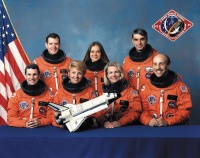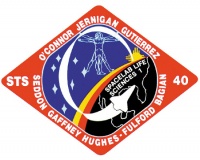STS-40
From The Space Library
 | |
| Organization | NASA-Office of Space Flight (United States) |
|---|---|
| Mission type | Human Crew,Life Science |
| Launch date | June 5, 1991 |
| Launch vehicle | Space Shuttle |
| Launch site | Cape Canaveral, United States |
| COSPAR ID | 1991-040A |
| Inclination | 39 degrees |
| Experiments | Here |
| Alternate Names | 21399 |
| Additional Information | Here |
| Data Collection | Here |
| Payload Mass Up | 11767 kg |
| Payload Mass Down | 11791.82 kg |
| Orbiter | Columbia |
| Lift Off Mass | 2,054,127.73 kg |
| Orbiter Weight at Liftoff | 113,817.27 kg |
| Orbiter Weight at Landing | 102,970.00 kg |
| Landed | Concrete runway 22 at Edwards AFB, Calif. |
| Orbits of Earth | 146 |
| Orbital Altitude | 160 nautical miles (184 statute miles) |
Contents |
[edit] Crew
- Commander: Bryan D. O'Conner
- Pilot: Sidney M. Gutierrez
- Payload Commander:
- Mission Specialist 1: M. Rhea Seddon
- Mission Specialist 2: James P. Bagian
- Mission Specialist 3: Tamara E. Jernigan
- Mission Specialist 4:
- Mission Specialist 5:
- Payload Specialist 1: Millie Hughes-Fulford
- Payload Specialist 2: F. Drew Gaffney
ISS/Mir Crew Transport
[edit] Mission
The first shuttle mission dedicated to life sciences began at 13:25, June 5, when Columbia lifted off from the Kennedy Space Center Pad 39B. The orbiter also carried 12 Get Away Specials and 7 NASA Orbiter Experiments. The crew itself was the focal point for the Spacelab Life Science (SLS-1) research to determine the causes of space sickness and note physical changes in microgravity conditions. The crew consisted of Commander Bryan D. O'Connor, Pilot Sidney M. Gutierrez, Mission Specialists James P. Bagian, Tamara E. Jernigan, Margaret R. Seddon, and Payload Specialists F. Drew Gaffney and Millie Highes-Fulford. The human crew was accompanied by 29 white rats and 2,500 jellyfish. The astronauts entered the Spacelab module 3 hrs, 44 mns into the flight, kicking off a rigorous work schedule in which they poked, prodded, spun, weighed, sampled, squeezed and monitored. It was the most concentrated life science research conducted in orbit since Skylab; the crew achieved 140% of mission goals. On flight day 2, concern was raised that torn insulation in the cargo bay might prevent the doors from closing. That unease was dispelled and a proposed spacewalk to make repairs was not needed. The 9-day, 2-hr, 14-mn mission ended on Edwards AFB runway 22 at 15:39, June 14.
[edit] EVA
[edit] Payload
Spacelab Life Sciences (SLS)-1 with long module; getaway special bridge assembly with 12 getaway specials; Physiological Monitoring System (PMS); Urine Monitoring System (UMS); Animal Enclosure Modules (AEM); Middeck Zero-gravity Dynamics Experiment (MODE); 7 Orbiter Experiments Program experiments
[edit] Books about the Space Shuttle Program
Buy This Book Click here |
Buy This Book here |
Buy This Book Click here |
Buy This Book Click here |





